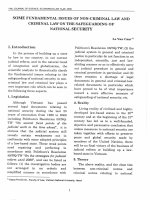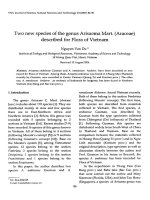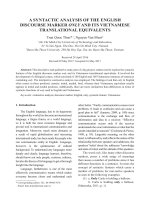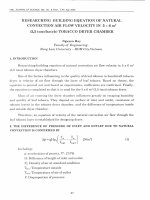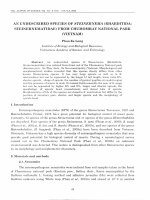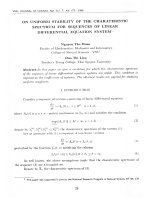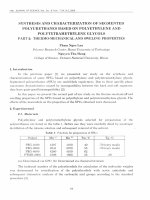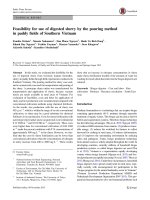DSpace at VNU: Four new species of Kockovaella isolated from plant leaves collected in Vietnam
Bạn đang xem bản rút gọn của tài liệu. Xem và tải ngay bản đầy đủ của tài liệu tại đây (957.8 KB, 14 trang )
J. Gen. Appl. Microbiol., 46, 297–310 (2000)
Full Paper
Four new species of Kockovaella isolated from plant
leaves collected in Vietnam
Dao Thi Luong,1,2,* Masako Takashima,1 Pham Van Ty,2
Nguyen Lan Dung,2 and Takashi Nakase1,†
1
Japan Collection of Microorganisms, RIKEN (The Institute of Physical and Chemical Research),
Wako, Saitama 351–0198, Japan
2
Vietnam Type Culture Collection, Centre of Applied Microbiology, University of Science,
Vietnam National University, Hanoi, Vietnam
(Received June 26, 2000; Accepted November 9, 2000)
Five ballistoconidiogenous yeast strains, isolated from plant leaves at Cuc Phuong National Forest of Ninh Binh, Vietnam, were assigned to the genus Kockovaella based on morphological and
chemotaxonomical characteristics. They represent four new species based on analyses of 18S
rDNA sequence, sequences of internal transcribed spacer regions, and DNA-DNA reassociation
experiments. Four new species, Kockovaella calophylli (1 strain), Kockovaella cucphuongensis
(2 strains), Kockovaella litseae (1 strain), and Kockovaella vietnamensis (1 strain) are proposed
for these strains.
Key Words——Kockovaella calophylli; Kockovaella cucphuongensis; Kockovaella litseae; Kockovaella
vietnamensis; systematics
Introduction
Kockovaella, a ballistoconidiogenous anamorphic
yeast genus, was described by Nakase et al. (1991).
This genus is characterized by the reproduction of ballistoconidia, nonballistosporous stalked conidia and
budding cells, Q-10 as the major ubiquinone, and the
presence of xylose in the cells. Six species are recognized in the genus: K. imperatae, K. thailandica
(Nakase et al., 1991), K. sacchari (Takashima and
Nakase, 1998), K. machilophila, K. phaffii, and K. schi* Address reprint requests to: Ms. Dao Thi Luong, Vietnam
Type Culture Collection, Centre of Applied Microbiology, University of Science, Vietnam National University, Hanoi, Vietnam.
†
Present Address: Yothi Research Unit, National Center for
Genetic Engineering and Biotechnology (BIOTEC), National
Science and Technology Development Agency, 73/1 Rama VI
Road, Bangkok 10400, Thailand.
mae (Cañete-Gibas et al., 1998).
During a survey of ballistoconidiogenous yeasts on
plant materials of Asia, five yeasts isolated from Vietnam were assigned to the genus Kockovaella. Four
new species are proposed for these five strains based
on analyses of 18S rDNA sequence, sequences of internal transcribed spacer (ITS) regions, and DNA-DNA
reassociation experiments.
Materials and Methods
Yeast strains. The yeast strains used in this study
were isolated from plant leaves collected in Cuc
Phuong National Forest of Ninh Binh, Vietnam (Table
1), using the ballistoconidium-fall method on YM agar
as reported by Nakase and Takashima (1993).
Morphological, physiological, and biochemical characteristics. Most methods used for the examination
of morphological, physiological, and biochemical char-
298
LUONG et al.
Table 1.
Vol. 46
Strains used in this study.
DDBJ accession numbers
Species
Kockovaella sp. 1
Kockovaella sp. 2
Kockovaella sp. 2
Kockovaella sp. 3
Kockovaella sp. 4
K. schimae
Fellomyces chinensis
F. distylii
F. lichenicola
F. sichuanensis
T
Strain
VY-61
VY-67
VY-125
VY-127
VY-137
JCM 10051T
JCM 10164T
JCM 9862T
JCM 10165T
JCM 10166T
Source
Litsea euosma
Schimastoglottis calyptrata
Smilax glabra
Bambusa schijostachyoides
Calophyllum membranaceum
Schima mertensiana
Physcia atrostriata, Heterodermia albicans, or Phlyctis argena
Distylium lepidotum
Physcia atrostriata, Heterodermia albicans, or Phlyctis argena
Physcia atrostriata, Heterodermia albicans, or Phlyctis argena
18S rDNA
ITS & 5.8S
AB042218
AB042219
AB042220
AB042221
AB042222
AB042223
AB042224
AB042225
AB042226
AB042227
AB042228
AB042229
AB042230
AB042231
AB042232
Type strain.
acteristics were described by Yarrow (1998). The determination of maximum growth temperature was
made in YM broth, using metal block baths. The assimilation of nitrogen compounds was determined by
the method of Nakase and Suzuki (1986). The vitamin
requirement followed the method by Komagata and
Nakase (1967).
Chemotaxonomic characteristics. Extraction, purification, and identification of ubiquinones were carried out according to the method of Nakase and
Suzuki (1986). The presence or absence of xylose in
the cells was analyzed by thin-layer chromatography
(Nakase et al., 1976) after hydrolizing the cells with trifluoroacetic acid (Suzuki and Nakase, 1988).
Sequencing and phylogenetic analysis. The sequences of 18S rDNA and ITS regions, including 5.8S
rDNA, was determined after amplifying the DNA by
using PCR. Both strands were sequenced directly
(Takashima and Nakase, 1999). Generated sequences
were aligned with related species by using the
CLUSTAL W ver. 1.74 computer program (Thompson
et al., 1994). Reference sequences used for the phylogenetic study were obtained from the database (Table
2). The phylogenetic tree was constructed from the
evolutionary distance data according to Kimura (1980)
by use of the neighbor-joining method (Saitou and Nei,
1987). Sites where gaps existed in any sequences
were excluded. Bootstrap analyses (Felsenstein,
1985) were performed from 1,000 random resamplings. For a comparison of ITS regions among closely
related species, pairwise sequences were aligned by
sight, and the sequence similarity including gaps was
calculated.
DNA-DNA relatedness. Isolation and purification of
DNA used the methods of Takashima and Nakase
(2000). The DNA base composition was determined by
HPLC after the enzymatic digestion of DNA to deoxyribonucleosides (Tamaoka and Komagata, 1984). The
DNA-GC Kit (Yamasa Shoyu Co. Ltd., Chiba, Japan)
was used as a quantitative standard. DNA-DNA reassociation experiments used a membrane-filter method
(Hamamoto and Nakase, 1995).
Results and Discussion
Five isolates (VY-61, VY-67, VY-I25, VY-127, and
VY-137) were characterized by the presence of xylose
in the cells, Q-10 as a major ubiquinone, the production of symmetrical ballistoconidia, the proliferation by
stalked conidia, and budding cells. The isolates were
identified in the genus Kockovaella (Nakase et al.,
1991).
The 18S rDNA sequences of five Kockovaella isolates were determined and a phylogenetic tree for
these isolates and 45 species of the genera Bullera,
Cryptococcus, Fellomyces, and Kockovaella was constructed by the neighbor-joining method based on
1,674 bases (Fig. 1). The result showed that five isolates were in a cluster and closely related with Fellomyces chinensis (Prillinger et al., 1997), F. distylii
(Hamamoto et al., 1998), F. lichenicola, F. sichuanensis (Prillinger et al., 1997), and Kockovaella schimae.
The sequences of ITS regions were determined and
the sequence similarity was calculated between five
2000
Four new species of Kockovaella
Table 2.
299
18S rDNA sequence data obtained from the databank for constructing the phylogenetic tree.
Scientific name
Bullera armeniaca
Bullera coprosmaensis
Bullera crosea
Bullera dendrophila
Bullera globispora
Bullera hannae
Bullera huiaensis
Bullera miyagiana
Bullera mrakii
Bullera oryzae
Bullera penniseticola
Bullera pseudoalba
Bullera sinensis
Bullera unica
Bullera variabilis
Bulleromyces albus
Cryptococcus amylolentus
Cryptococcus cellulolyticus
Cryptococcus dimennae
Cryptococcus flavus
Cryptococcus heveanensis
Cryptococcus hungaricus
Cryptococcus laurentii
DDBJ/EMBL/
GenBank No.
D78323
D78326
D31648
D31649
D31650
D78327
D78331
D31651
D78325
D31652
AB005452
D31660
D78328
D78330
D31654
X60179
AB032619
AB032624
AB032627
AB032629
AB032635
AB032638
AB032640
isolates of the genus Kockovaella and phylogenetically
closely related species (Table 3). The results showed
that those of VY-67 and VY-125 were identical and
showed 97.6–99.1% sequence similarity for ITS1 and
97.1–99.1% for ITS2 between other isolates. Those of
VY-61, VY-127, and VY-137 showed 99.1–100%,
97.1–99.1%, and 97.1–100% sequence similarity for
ITS1 and 96.5–98.2%, 97.1–99.2%, and 99.1–99.2%
for ITS2, respectively, between other isolates. They
showed less than 90% similarity for ITS1 and 86.8–
96.4% for ITS2 between closely related species.
These results indicated that Kockovaella strains isolated from plants of Vietnam were distinct from known
Fellomyces and Kockovaella species, and they were
closely related to each other (Sugita et al., 1999). ITS
sequence data also indicated that F. chinensis and F.
lichenicola were phylogenetically closely related. For
the two species, we will discuss another paper.
DNA-DNA reassociation experiments were carried
out among five isolates and phylogenetically related
species (Table 4). Two strains VY-67 and VY-125
showed a high DNA relatedness with each other
Scientific name
Cryptococcus luteolus
Cryptococcus podzolicus
Fellomyces borneensis
Fellomyces chinensis
Fellomyces distylii
Fellomyces fuzhouensis
Fellomyces horovitziae
Fellomyces lichenicola
Fellomyces ogasawarensis
Fellomyces penicillatus
Fellomyces polyborus
Fellomyces sichuanensis
Fellomyces thailandicus
Kockovaella imperatae
Kockovaella machilophila
Kockovaella phaffii
Kockovaella sacchari
Kockovaella schimae
Kockovaella thailandica
Udeniomyces megalosporus
Udeniomyces pyricola
Udeniomyces puniceus
DDBJ/EMBL/
GenBank No.
AB032641
AB032645
AB032659
AB032660
AB001036
AB001032
AB001033
AB032661
AB001035
AB001034
D64117
AB032662
AB044804
AB005561
AB005479
AB005480
AB005453
AB005482
D64133
D31657
D31659
D31658
(84–93%) and low reassociation values between other
isolates (33–47%) and to reference species (2–17%).
Strains VY-61 and VY-127 showed low reassociation
values between other isolates (31–35% and 15–28%,
respectively) and to reference species (2–16% and
2–10%, respectively). Strain VY-137 showed 52–73%
relatedness with other isolates at 67°C, when DNA of
VY-137 was employed as a probe, whereas it showed
25–47% relatedness when those of other isolates were
employed as probes. When the experiments were carried out at 69°C, DNA relatedness between VY-137
and other Kockovaella isolates were a little lower than
those at 67°C (31–56%). The experiments performed
again at 74°C, using the same filters, showed the low
reassociation values between other isolates (33–44%).
These results indicated that the loosely bound DNA on
the filters at 67°C or 69°C was released at an elevated
temperature. Based on the facts, two strains, VY-67
and VY-125, were considered to represent a single
new species, and strains VY-61, VY-127, and VY-137
represented three different new species.
Because these four new species are closely related
300
LUONG et al.
Vol. 46
Fig. 1. Phylogenetic tree of five isolates of the genus Kockovaella and related species based on the 18S rDNA sequences.
The tree was constructed from the evolutionary distance data according to Kimura (1980), using the neighbor-joining method
(Saitou and Nei, 1987) with bootstrapping (Felsenstein, 1985). The numerals represent results from 1,000 replicate bootstrap samplings (a frequency of less than 50% is not shown).
as described above and shown in Table 5, however,
they can distinguish from each other by the combination of assimilation ability of glycerol, erythritol, ribitol,
2-ketogluconic acid, DL-lactic acid, and inositol. They
are also discriminated from each other by ITS sequences (Fig. 2, A and B).
2000
Four new species of Kockovaella
a
98.2
99.1
100
—
98.3
88.2
86.7
86.7
86.6
84.2
96.5
99.2
97.1
97.1
—
86.6
85.8
85.8
85.7
84.3
93.6
91.8
94.1
94.1
91.3
—
86.7
86.7
84.0
81.8
96.4
94.7
95.9
95.9
94.2
94.2
—
100
92.4
78.5
JCM 9862
98.2
99.1
—
100
98.3
88.2
86.7
86.7
86.6
84.2
JCM 10166
97.0
—
97.6
97.6
97.1
87.4
86.7
86.7
86.6
83.4
JCM 10165
—
100
99.1
99.1
99.1
87.4
86.7
86.7
86.6
83.4
JCM 10164
JCM 10051
VY-61
VY-137
VY-67
VY-125
VY-127
JCM 10051
JCM 10164
JCM 10165
JCM 10166
JCM 9862
VY-127
Kockovaella sp. 1
Kockovaella sp. 4
Kockovaella sp. 2
Kockovaella sp. 2
Kockovaella sp. 3
K. shimae
Fellomyces chinensis
F. lichenicola
F. sichuanensis
F. distylii
VY-125
Strain
VY-67
Species
VY-137
Sequence similarities of ITS region among five Kockovaella isolates and related species.a
VY-61
Table 3.
301
95.9
94.1
96.4
96.4
93.6
94.3
98.2
—
92.4
90.0
95.9
94.7
95.3
95.3
94.2
94.2
95.9
95.6
—
86.5
87.8
89.0
87.2
87.2
86.8
87.8
90.6
78.5
81.8
—
Lower left triangle shows sequence similarities in ITS1 and upper right triangle shows them in ITS2.
Table 4.
DNA-DNA reassociation experiment among five Kockovaella isolates and related species.
Kockovaella sp. 1
Kockovaella sp. 2
Kockovaella sp. 2
Kockovaella sp. 3
Kockovaella sp. 4
K. schimae
Fellomyces chinensis
F. distylii
F. lichenicola
F. sichuanensis
VY-61
VY-67
VY-125
VY-127
VY-137
JCM 10051
JCM 10164
JCM 9862
JCM 10165
JCM 10166
53.2
53.6
53.6
54.1
53.5
52.8
54.8
50.2
53.3
54.3
100
ND
35
33
31
16
7
3
4
2
ND
100
93
ND
ND
ND
ND
ND
ND
ND
33
84
100
47
47
17
6
5
7
3
15
ND
28
100
25
10
4
3
3
2
52
ND
69
73
100
26
11
6
6
2
9
ND
9
10
8
100
3
4
3
1
VY-137
67°C
VY-137
JCM 10051
VY-137
VY-127
Mol% GϩC
VY-125
Strain
VY-67
Species
VY-61
% relative binding of DNA from
69°C
74°C
31
56
51
44
100
9
3
3
4
4
30
44
44
30
100
5
4
2
7
3
ND, not determined.
Description of New Taxa
Kockovaella calophylli Luong, Takashima, Ty, Dung
& Nakase, sp. nov.
In liquido “YM” post dies 5 ad 17°C, cellulae vegetativae sphaericae vel ovoideae aut ogiveae, 2.0–4.0ϫ
2.0–6.0 mm, singulae, binae, in catenis aut in fasciculis,
propagantes formatione conidiorum stipitatorum et
gemmarum blasticarum. Post unum mensem ad 17°C,
pellicula fragilis et sedimentum formantur. Cultura in
agaro “YM,” gilvus-flava, rugosa, non nitida et margine
erosa. Pseudomycelium formatur. Ballistoconidia apiculata, 2.0–3.0ϫ3.0–6.0 mm.
Fermentatio nulla. Glucosum, galactosum, L-sorbosum (lente et exiguum), sucrosum, maltosum, cellobiosum, trehalosum, lactosum, melibiosum, raffinosum, melezitosum, amylum solubile, D-xylosum, Larabinosum (lente), D-arabinosum (exiguum), D-ribo-
302
LUONG et al.
sum, L-rhamnosum (lente), galactitolum (lente et exiguum), D-mannitolum (lente), D-glucitolum (exiguum),
salicinum (lente et exiguum), glucuno-d-lactonum
(lente et exiguum), acidum 5-ketogluconicum (lente et
exiguum), acidum D-glucuronicum (lente), acidum Dgalacturonicum (lente), acidum succinicum (lente) et
acidum citricum (lente) assimilantur at non inulinum,
ethanolum, glycerolum, erythritolum, ribitolum, amethyl-D-glucosidum,
acidum
2-ketogluconicum,
acidum DL-lacticum nec inositolum. Ammonium sulfatum et L-lysinum assimilantur at non kalium nitricum,
natrium nitrosum, cadaverinum nec ethylaminum.
Maxima temperatura crescentiae: 31–32°C. Ad crescentiam thiaminum necessarium est et niacinum stimulare. Materia amyloidea iodophila non formantur.
Ureum hydrolysatur. Diazonium caeruleum B: Positivum. Proportio molaris guaniniϩcytosini in acido deoxyribonucleico: 53.5 mol% per HPLC. Systema
Vol. 46
ubiquini: Q-10. Xylosum in cellulis presens.
Holotypus: Isolatus ex folio Calophylli membranacei, Vietnam, JCM 10842/VTCC1 0180 (originaliter ut
VY-137) conservatur in collectionibus culturarum quas
“Japan Collection of Microorganisms,” Wako, Saitama
et “Vietnam Type Culture Collection,” Hanoi, Vietnam
sustentat.
Growth in YM broth: After 5 days at 17°C, the vegetative cells are spherical to ovoidal with a few ogival
ones and measure 2.0–4.0ϫ2.0–6.0 mm. They occur
singly, in pairs or in groups, and reproduce by budding
and stalked conidia (Fig. 3). Stalked conidia are observed in both pellicle and sediment. The conidia are
separated at the distal end of the stalks from parent
cells. A sediment and a dull, wrinkled climbing pellicle
are formed after one month at 17°C.
Growth in YM agar: After one month at 17°C, the
streak culture is light yellow, wrinkled, dull, and rough
(A)
2000
Four new species of Kockovaella
303
(B)
Fig. 2. Primary structure of the ITS1 (A) and ITS2 (B) sequences among five Kockovaella isolates and related species.
K_shim_10051, Kockovaella shimae JCM 10051; F_chin_10164, Fellomyces chinensis JCM 10164; F_lich_10165, F. lichenicola
JCM 10165; F_sich_10166, F. sichuanensis JCM 10166; F_dist_9862, F. distylii JCM 9862.
netted, and it has an erose margin. Stalked conidia
and ballistoconidia are produced.
Dalmau plate culture on corn meal agar:
Pseudomycelium is formed after 2 weeks of incubation
at 17°C.
Formation of ballistoconidia: Ballistoconidia are
formed abundantly on corn meal agar after 3 days incubation at 17°C (Fig. 3). They are symmetrical and
apiculate, measuring 2.0–3.0ϫ3.0–6.0 mm.
Fermentation: Absent.
Assimilation of carbon compounds:
Glucose
ϩ
Galactose
ϩ
L-Sorbose
ϩ (latent and weak)
Sucrose
ϩ
Maltose
Cellobiose
Trehalose
Lactose
Melibiose
Raffinose
Melezitose
Inulin
Soluble starch
D-Xylose
L-Arabinose
D-Arabinose
D-Ribose
L-Rhamnose
Ethanol
ϩ
ϩ
ϩ
ϩ
ϩ
ϩ
ϩ
Ϫ
ϩ
ϩ
ϩ (slow)
ϩ (weak)
ϩ
ϩ (slow)
Ϫ
JCM 10842T
JCM 10840T
JCM 10839
JCM 10838T
JCM 10841T
JCM 10051T
JCM 10164T
JCM 9862T
JCM 10165T
JCM 10166T
Kockovaella calophylli
Kockovaella cucphuongensis
Kockovaella cucphuongensis
Kockovaella listeae
Kockovaella vietnamensis
K. schimae b
Fellomyces chinensis
F. distylii c
F. lichenicola
F. sichuanensis
ϩ
ϩ
ϩ
ϩ
ϩ
ϩ
Ϫ
Ϫ
Ϫ
Ϫ
Formation of
ballistoconidia
lw
w
w
w
lw
Ϫ
Ϫ
ϩ
Ϫ
Ϫ
ϩ
ϩ
ϩ
l
ϩ
lw
ϩ
ϩ
ϩ
l
ϩ
s
l
l
l
Ϫ
ϩ
ϩ
w
w
ϩ
l
l
ϩ
l
l
ϩ
ϩ
s
s
s
l
l
l
s
ϩ
ϩ
ϩ
s
ϩ
w
l
s
l
s
l
w
ϩ
lw
s
ϩ
ϩ
l
ϩ
ϩ
lw
lw
ϩ
lw
w
a
Type strain.
ϩ, positive; Ϫ, negative; l, latent; s, slow; w, weak; lw, latent and weak.
b
Canete-Gibas et al. (1998).
c
Hamamoto et al. (1998).
T
Strain
Species
s
l
s
l
l
l
s
Ϫ
w
w
Ϫ
Ϫ
lw
lw
lw
Ϫ
Ϫ
ϩ
Ϫ
Ϫ
Ϫ
lw
w
lw
lw
Ϫ
lw
ϩ
lw
lw
Ϫ
s
w
lw
Ϫ
lw
w
ϩ
lw
lw
lw
l
s
s
w
ϩ
w
ϩ
w
lw
s
l
s
ϩ
w
ϩ
ϩ
ϩ
l
lw
w
s
lw
w
lw
l
s
ϩ
lw
Ϫ
lw
w
w
w
w
Ϫ
l
ϩ
s
w
lw
s
w
w
w
lw
ϩ
ϩ
l
ϩ
Ϫ
s
s
Ϫ
lw
Ϫ
l
ϩ
s
w
lw
w
lw
w
w
Ϫ
l
ϩ
w
w
Ϫ
Ϫ
lw
lw
Ϫ
Ϫ
lw
Ϫ
lw
lw
l
l
s
ϩ
ϩ
lw
l
ϩ
s
s
s
s
w
w
w
lw
l
ϩ
s
w
Ϫ
Ϫ
Ϫ
s
w
Ϫ
ϩ
Ϫ
w
l
L-Sorbose
Lactose
Melibiose
Raffinose
L-Arabinose
D-Arabinose
D-Ribose
L-Rhamnose
Glycerol
Erythritol
Ribitol
Galactitol
D-Mannitol
D-Glucitol
Salicin
Glucono-d-lactone
2-Ketogluconic acid
5-Ketogluconic acid
DL-Lactic acid
Succinic acid
Citric acid
Inositol
Carbon source
s
ϩ
l
ϩ
ϩ
l
ϩ
ϩ
l
l
D-Galacturonic
s
ϩ
s
ϩ
ϩ
l
ϩ
ϩ
l
s
acid
acid
D-Glucuronic
Assimilation of a
Nitrogen source
Ϫ
Ϫ
Ϫ
Ϫ
Ϫ
Ϫ
lw
Ϫ
lw
lw
Potassium nitrate
Salient characteristics of Kockovaella isolates and related species.
Ϫ
Ϫ
Ϫ
Ϫ
Ϫ
Ϫ
Ϫ
Ϫ
lw
lw
Vitamin requirements and
vitamin stimulation
Ϫ Thiamine, niacin
Ϫ
Thiamine
Ϫ
Thiamine
Ϫ
Thiamine
Ϫ
Thiamine
Ϫ
Thiamine
lw
Thiamine
Ϫ
Thiamine
lw
Thiamine
lw
Thiamine
Ethylamine
hydrochloride
Cadaverine
dihydrochloride
Table 5.
Maximum growth
temperature (°C)
31–32
29–30
29–30
29–30
31–32
28–29
29–30
27Ϫ28
28–29
31–32
304
LUONG et al.
Vol. 46
2000
Four new species of Kockovaella
Fig. 3. Kockovaella calophylli JCM 10842.
(A) Vegetative cells grown in YM broth for 5 days at 17°C. (B)
Ballistoconidia produced on corn meal agar after 3 days at
17°C. Scale bars indicate 10 mm.
Glycerol
Ϫ
Erythritol
Ϫ
Ribitol
Ϫ
Galactitol
ϩ (latent and weak)
D-Mannitol
ϩ (slow)
D-Glucitol
ϩ (weak)
a-Methyl-D-glucoside
Ϫ
Salicin
ϩ (latent and weak)
Glucono-d-lactone
ϩ (latent and weak)
2-Ketogluconic acid
Ϫ
5-Ketogluconic acid
ϩ (latent and weak)
D-Glucuronic acid
ϩ (slow)
D-Galacturonic acid
ϩ (slow)
DL-Lactic acid
Ϫ
Succinic acid
ϩ (latent)
Citric acid
ϩ (latent)
Inositol
Ϫ
Assimilation of nitrogen compounds:
Ammonium sulfate
ϩ
Potassium nitrate
Ϫ
Sodium nitrite
Ϫ
Ethylamine hydrochloride
Ϫ
L-Lysine hydrochloride
ϩ
Cadaverine dihydrochloride
Ϫ
Maximum growth temperature: 31–32°C.
Vitamins: Thiamine required and niacin stimulated.
Production of starch-like substances: Negative.
Diazonium blue B color reaction: Positive.
Urease: Positive.
Liquefaction of gelatin: Negative.
Acid production on chalk agar: Negative.
GϩC content of nuclear DNA: 53.5 mol% (by
305
HPLC).
Ubiquinone system: Q-10.
Xylose in the cells: Present.
Strain examined: Strain VY-137 was isolated by
Dao Thi Luong in February 1999 from a leaf of Calophyllum membranaceum Gard (Guttiferae), collected
by Dao Thi Luong and Takashi Nakase at Cuc Phuong
National Forest of Ninh Binh, Vietnam. This strain has
been deposited in Japan Collection of Microorganisms
(JCM), RIKEN (The Institute of Physical and Chemical
Research), Wako, Saitama, Japan, and at the Vietnam
Type Culture Collection (VTCC), Centre of Applied Microbiology, University of Science, Vietnam National
University, Hanoi, Vietnam, with the accession numbers JCM 10842 and VTCC1 0180, respectively.
Kockovaella cucphuongensis Luong, Takashima, Ty,
Dung & Nakase, sp. nov.
In liquido “YM” post dies 5 ad 17°C, cellulae vegetativae sphaericae vel ovoideae aut ogiveae, 3.0–5.0ϫ
3.0–7.0 mm, singulae, binae, in catenis aut in fasciculis,
propagantes formatione conidiorum stipitatorum et
gemmarum blasticarum. Post unum mensem ad 17°C,
pellicula fragilis et sedimentum formantur. Cultura in
agaro “YM,” gilvus-flava, rugosa, non nitida et margine
erosa. Pseudomycelium formatur. Ballistoconidia apiculata, 2.5–3.5ϫ2.5–7.0 mm.
Fermentatio nulla. Glucosum, galactosum, L-sorbosum (exiguum), sucrosum, maltosum, cellobiosum,
trehalosum, lactosum, melibiosum (lente), raffinosum
(lente), melezitosum, amylum solubile, D-xylosum, Larabinosum (lente), D-arabinosum (lente), D-ribosum,
L-rhamnosum (lente), erythritolum (lente et exiguum),
ribitolum (lente), galactitolum (lente), D-mannitolum
(lente), D-glucitolum (lente), salicinum (exiguum), glucono-d-lactonum (lente), acidum 2-ketogluconicum
(lente), acidum 5-ketogluconicum (exiguum), acidum
D-glucuronicum, acidum D-galacturonicum, acidum
succinicum (lente) et acidum citricum (lente), assimilantur at non inulinum, ethanolum, glycerolum, amethyl-D-glucosidum, acidum DL-lacticum nec inositolum. Ammonium sulfatum et L-lysinum assimilantur
at non kalium nitricum, natrium nitrosum, cadaverinum
nec ethylaminum. Maxima temperatura crescentiae:
29–30°C. Ad crescentiam thiaminum necessarium est.
Materia amyloidea iodophila non formantur. Ureum hydrolysatur. Diazonium caeruleum B: Positivum. Proportio molaris guaniniϩcytosini in acido deoxyribonucleico: 53.7 mol% per HPLC. Systema ubiquini: Q-10. Xy-
306
LUONG et al.
losum in cellulis presens.
Holotypus: Isolatus ex folio Smilacis glabrae, Vietnam, JCM 10840/VTCC1 0177 (originaliter ut VY-125)
conservatur in collectionibus culturarum quas “Japan
Collection of Microorganisms,” Wako, Saitama et “Vietnam Type Culture Collection,” Hanoi, Vietnam sustentat.
Growth in YM broth: After 5 days at 17°C, the vegetative cells are spherical to ovoidal with a few ogival
ones and measure 3.0–5.0ϫ3.0–7.0 mm. They occur
singly, in pairs or in groups, and reproduce by budding
and stalked conidia (Fig. 4). Stalked conidia are observed in both pellicle and sediment. The conidia are
separated at the distal end of the stalks from parent
cells. A sediment and a dull, wrinkled climbing pellicle
are formed after one month at 17°C.
Growth in YM agar: After one month at 17°C, the
streak culture is light yellow, wrinkled, dull, and has an
erose margin.
Dalmau plate culture on corn meal agar:
Pseudomycelium is formed after 2 weeks of incubation
at 17°C.
Formation of ballistoconidia: Ballistoconidia are
formed abundantly on corn meal agar after 3 days incubation at 17°C (Fig. 4). They are symmetrical and
apiculate, measuring 2.5–3.5ϫ2.5–7.0 mm.
Fermentation: Absent.
Assimilation of carbon compounds:
Glucose
ϩ
Galactose
ϩ
L-Sorbose
ϩ (weak)
Sucrose
ϩ
Maltose
ϩ
Cellobiose
ϩ
Trehalose
ϩ
Lactose
ϩ
Melibiose
ϩ (slow)
Raffinose
ϩ (latent)
Melezitose
ϩ
Inulin
Ϫ
Soluble starch
ϩ
D-Xylose
ϩ
L-Arabinose
ϩ (latent)
D-Arabinose
ϩ (latent)
D-Ribose
ϩ
L-Rhamnose
ϩ (latent)
Ethanol
Ϫ
Glycerol
Ϫ
Erythritol
ϩ (latent and weak)
Vol. 46
Fig. 4. Kockovaella cucphuongensis.
(A) Vegetative cells grown in YM broth for 5 days at 17°C of
JCM 10840. (B) Ballistoconidia produced on corn meal agar
after 3 days at 17°C of JCM 10840. (C) Vegetative cells grown
in YM broth for 5 days at 17°C of JCM 10839. (D) Ballistoconidia produced on corn meal agar after 3 days at 17°C of JCM
10839. Scale bars indicate 10 mm.
Ribitol
ϩ (slow)
Galactitol
ϩ (slow)
D-Mannitol
ϩ (latent)
D-Glucitol
ϩ (slow)
a-Methyl-D-glucoside
Ϫ
Salicin
ϩ (weak)
Glucono-d-lactone
ϩ (latent)
2-Ketogluconic acid
ϩ (latent)
5-Ketogluconic acid
ϩ (weak)
D-Glucuronic acid
ϩ
D-Galacturonic acid
ϩ
DL-Lactic acid
Ϫ
Succinic acid
ϩ (latent)
Citric acid
ϩ (slow)
Inositol
Ϫ
Assimilation of nitrogen compounds:
Ammonium sulfate
ϩ
Potassium nitrate
Ϫ
2000
Four new species of Kockovaella
Sodium nitrite
Ϫ
Ethylamine hydrochloride
Ϫ
L-Lysine hydrochloride
ϩ
Cadaverine dihydrochloride Ϫ
Maximum growth temperature: 29–30°C.
Vitamin required: Thiamine.
Production of starch-like substances: Negative.
Diazonium blue B color reaction: Positive.
Urease: Positive.
Liquefaction of gelatin: Negative.
Acid production on chalk agar: Negative.
GϩC content of nuclear DNA: 53.7 mol% (by
HPLC).
Ubiquinone system: Q-10.
Xylose in the cells: Present.
Strain examined: Type strain VY-125 was isolated
by Dao Thi Luong in February 1999 from leaves of a
green brier, Smilax glabra Roxb, and strain VY-67 was
isolated from leaves of an aroid, Schimastoglottis calyptrata Zoll. & Mor. collected by Dao Thi Luong and
Takashi Nakase at Cuc Phuong National Forest of
Ninh Binh, Vietnam. These strains have been deposited in JCM and VTCC with the accession numbers
JCM 10840 and VTCC1 0177 for VY-125 and JCM
10839 and VTCC1 0178 for VY-67, respectively.
Kockovaella litseae Luong, Takashima, Ty, Dung &
Nakase, sp. nov.
In liquido “YM” post dies 5 ad 17°C, cellulae vegetativae sphaericae vel ovoideae aut ogiveae, 3.0–6.0ϫ
3.5–8.0 mm, singulae, binae, in catenis aut in fasciculis,
propagantes formatione conidiorum stipitatorum et
gemmarum blasticarum. Post unum mensem ad 17°C,
pellicula fragilis et sedimentum formantur. Cultura in
agaro “YM,” gilvus-flava vel gilvus-aurantiaca, rugosa,
hebes, aspera et margine erosa. Pseudomycelium formatur. Ballistoconidia apiculata, 2.5–4.0ϫ2.5–6.0 mm.
Fermentatio nulla. Glucosum, galactosum, L-sorbosum (exiguum), sucrosum, maltosum, cellobiosum,
trehalosum, lactosum (lente), melibiosum (lente), raffinosum, melezitosum, amylum solubile, D-xylosum, Larabinosum (lente), D-arabinosum (lente), D-ribosum,
L-rhamnosum (lente), glycerolum (lente et exiguum),
erythritolum (lente et exiguum), ribitolum (lente et exiguum), galactitolum, D-mannitolum, D-glucitolum (exiguum), salicinum (exiguum), glucuno-d-lactonum (exiguum), acidum 5-ketogluconicum (exiguum), acidum
D-glucuronicum, acidum D-galacturonicum, acidum DLlacticum (lente et exiguum), acidum succinicum,
307
Fig. 5. Kockovaella litseae JCM 10838.
(A) Vegetative cells grown in YM broth for 5 days at 17°C.
(B) Ballistoconidia produced on corn meal agar after 3 days at
17°C. Scale bars indicate 10 mm.
acidum citricum (exiguum) et inositolum (lente) assimilantur at non inulinum, ethanolum, a-methyl-D-glucosidum nec acidum 2-ketogluconicum. Ammonium
sulfatum et L-lysinum assimilantur at non kalium nitricum, natrium nitrosum, cadaverinum nec ethylaminum. Maxima temperatura crescentiae: 29–30°C.
Ad crescentiam thiaminum necessarium est. Materia
amyloidea iodophila non formantur. Ureum hydrolysatur. Diazonium caeruleum B: Positivum. Proportio molaris guaniniϩcytosini in acido deoxyribonucleico: 53.2 mol% per HPLC. Systema ubiquini: Q-10. Xylosum in cellulis presens.
Holotypus: Isolatus ex folio Litseae euosmae, Vietnam, JCM 10838/VTCC1 0176 (originaliter ut VY-61)
conservatur in collectionibus culturarum quas “Japan
Collection of Microorganisms,” Wako, Saitama et “Vietnam Type Culture Collection,” Hanoi, Vietnam sustentat.
Growth in YM broth: After 5 days at 17°C, the vegetative cells are spherical to ovoidal with a few ogival
ones and measure 3.0–6.0ϫ3.5–8.0 mm. They occur
singly, in pairs or in groups, and reproduce by budding
and stalked conidia (Fig. 5). Stalked conidia are observed in both pellicle and sediment. The conidia are
separated at the distal end of the stalks from parent
cells. A sediment and a dull, wrinkled climbing pellicle
are formed after one month at 17°C.
Growth in YM agar: After one month at 17°C, the
streak culture is light yellow to light orange, wrinkled,
dull, or semishining near the bottom, and rough netted,
and it has an erose margin. Satellite colonies of ballistospores are observed on the agar.
308
LUONG et al.
Dalmau plate culture on corn meal agar:
Pseudomycelium is formed after 2 weeks of incubation
at 17°C.
Formation of ballistoconidia: Ballistoconidia are
formed abundantly on corn meal agar after 3 days at
17°C (Fig. 5). They are symmetrical and apiculate,
measuring 2.5–4.0ϫ2.5–6.0 mm.
Fermentation: Absent.
Assimilation of carbon compounds:
Glucose
ϩ
Galactose
ϩ
L-Sorbose
ϩ (weak )
Sucrose
ϩ
Maltose
ϩ
Cellobiose
ϩ
Trehalose
ϩ
Lactose
ϩ (latent)
Melibiose
ϩ (latent)
Raffinose
ϩ
Melezitose
ϩ
Inulin
Ϫ
Soluble starch
ϩ
D-Xylose
ϩ
L-Arabinose
ϩ (latent)
D-Arabinose
ϩ (latent)
D-Ribose
ϩ
L-Rhamnose
ϩ (latent)
Ethanol
Ϫ
Glycerol
ϩ (latent and weak)
Erythritol
ϩ (latent and weak)
Ribitol
ϩ (latent and weak)
Galactitol
ϩ (slow)
D-Mannitol
ϩ
D-Glucitol
ϩ (weak)
a-Methyl-D-glucoside
Ϫ
Salicin
ϩ (weak)
Glucono-d-lactone
ϩ (weak)
2-Ketogluconic acid
Ϫ
5-Ketogluconic acid
ϩ (weak)
D-Glucuronic acid
ϩ
D-Galacturonic acid
ϩ
DL-Lactic acid
ϩ (latent and weak)
Succinic acid
ϩ
Citric acid
ϩ (weak)
Inositol
ϩ (slow)
Assimilation of nitrogen compounds:
Ammonium sulfate
ϩ
Potassium nitrate
Ϫ
Sodium nitrite
Ϫ
Vol. 46
Ethylamine hydrochloride
Ϫ
L-Lysine hydrochloride
ϩ
Cadaverine dihydrochloride
Ϫ
Maximum growth temperature: 29–30°C.
Vitamin required: Thiamine.
Production of starch-like substances: Negative.
Diazonium blue B color reaction: Positive.
Urease: Positive.
Liquefaction of gelatin: Negative.
Acid production on chalk agar: Negative.
GϩC content of nuclear DNA: 53.2 mol% (by
HPLC).
Ubiquinone system: Q-10.
Xylose in the cells: Present.
Strain examined: Strain VY-61 was isolated by
Dao Thi Luong in February 1999 from a leaf of Litsea
euosma J. J. Sm. (Lauraceae), collected by Dao Thi
Luong and Takashi Nakase at Cuc Phuong National
Forest of Ninh Binh, Vietnam. This strain has been deposited in JCM and VTCC with the accession numbers
JCM 10838 and VTCC1 0176, respectively.
Kockovaella vietnamensis Luong, Takashima, Ty,
Dung & Nakase, sp. nov.
In liquido “YM” post dies 5 ad 17°C, cellulae vegetativae sphaericae vel ovoideae aut ogiveae, 3.0–4.0ϫ
3.0–6.0 m m, singulae, binae, in catenis aut in fasciculis,
propagantes formatione conidiorum stipitatorum et
gemmarum blasticarum. Post unum mensem ad 17°C,
pellicula fragilis et sedimentum formantur. Cultura in
agaro “YM,” gilvus-aurantiaca, rugosa, non nitida et
margine erosa. Pseudomycelium formatur. Ballistoconidia apiculata, 2.5–6.0ϫ2.5–8.0 mm.
Fermentatio nulla. Glucosum, galactosum, L-sorbosum (lente et exiguum), sucrosum, maltosum, cellobiosum, trehalosum, lactosum, melibiosum (lente),
raffinosum (lente), melezitosum, amylum solubile, Dxylosum, L-arabinosum (lente), D-arabinosum (lente),
D-ribosum, L-rhamnosum (lente), glycerolum (lente et
exiguum), erythritolum (lente et exiguum), galactitolum
(exiguum), D-mannitolum (exiguum), D-glucitolum
(lente et exiguum), salicinum (exiguum), glucuno-d-lactonum (exiguum), acidum 2-ketogluconicum (lente et
exiguum), acidum 5-ketogluconicum (exiguum),
acidum D-glucuronicum, acidum D-galacturonicum,
acidum succinicum, acidum citricum (exiguum) et inositolum (exiguum) assimilantur at non inulinum,
ethanolum, ribitolum, a-methyl-D-glucosidum nec
acidum DL-lacticum. Ammonium sulfatum et L-lysinum
2000
Four new species of Kockovaella
assimilantur at non kalium nitricum, natrium nitrosum,
cadaverinum nec ethylaminum. Maxima temperatura
crescentiae: 31–32°C. Ad crescentiam thiaminum necessarium est. Materia amyloidea iodophila non formantur. Ureum hydrolysatur. Diazonium caeruleum B:
Positivum. Proportio molaris guaniniϩcytosini in acido
deoxyribonucleico: 54.1 mol% per HPLC. Systema
ubiquini: Q-10. Xylosum in cellulis presens.
Holotypus: Isolatus ex folio Bambusae schijostachyoidis, Vietnam, JCM 10841/VTCC1 0179 (originaliter ut VY-127) conservatur in collectionibus culturarum quas “Japan Collection of Microorganisms,”
Wako, Saitama et “Vietnam Type Culture Collection,”
Hanoi, Vietnam sustentat.
Growth in YM broth: After 5 days at 17°C, the vegetative cells are spherical to ovoidal with a few ogival
ones and measure 3.0–4.0ϫ3.0–6.0 mm. They occur
singly, in pairs or in groups, and reproduce by budding
and stalked conidia (Fig. 6). Stalked conidia are observed in both pellicle and sediment. The conidia are
separated at the distal end of the stalks from the parent cells. A sediment and a dull, wrinkled climbing pellicle are formed after one month at 17°C.
Growth in YM agar: After one month at 17°C, the
streak culture is light orange, wrinkled, dull, and rough
netted, and it has an erose margin. Satellite colonies
of ballistoconidia are observed on the agar.
Dalmau plate culture on corn meal agar:
Pseudomycelium is formed after 2 weeks of incubation
at 17°C.
Formation of ballistoconidia: Ballistoconidia are
formed abundantly on corn meal agar after 3 days incubation at 17°C (Fig. 6). They are symmetrical and
apiculate, measuring 2.5–6.0ϫ2.5–8.0 mm.
Fermentation: Absent.
Assimilation of carbon compounds:
Glucose
ϩ
Galactose
ϩ
L-Sorbose
ϩ (latent and weak)
Sucrose
ϩ
Maltose
ϩ
Cellobiose
ϩ
Trehalose
ϩ
Lactose
ϩ
Melibiose
ϩ (latent)
Raffinose
ϩ (latent)
Melezitose
ϩ
Inulin
Ϫ
Soluble starch
ϩ
309
Fig. 6. Kockovaella vietnamensis JCM 10841.
(A) Vegetative cells grown in YM broth for 5 days at 17°C.
(B) Ballistoconidia produced on corn meal agar after 3 days at
17°C. Scale bars indicate 10 mm.
ϩ
ϩ (slow)
D-Arabinose
ϩ (slow)
D-Ribose
ϩ
L-Rhamnose
ϩ (latent)
Ethanol
Ϫ
Glycerol
ϩ (latent and weak)
Erythritol
ϩ (latent and weak)
Ribitol
Ϫ
Galactitol
ϩ (weak)
D-Mannitol
ϩ (weak)
D-Glucitol
ϩ (latent and weak)
a-Methyl-D-glucoside
Ϫ
Salicin
ϩ (weak)
Glucono-d-lactone
ϩ (weak)
2-Ketogluconic acid
ϩ (latent and weak)
5-Ketogluconic acid
ϩ (weak)
D-Glucuronic acid
ϩ
D-Galacturonic acid
ϩ
DL-Lactic acid
Ϫ
Succinic acid
ϩ
Citric acid
ϩ (weak)
Inositol
ϩ (weak)
Assimilation of nitrogen compounds:
Ammonium sulfate
ϩ
Potassium nitrate
Ϫ
Sodium nitrite
Ϫ
Ethylamine hydrochloride
Ϫ
L-Lysine hydrochloride
ϩ
Cadaverine dihydrochloride
Ϫ
Maximum growth temperature: 31–32°C.
Vitamin required: Thiamine.
D-Xylose
L-Arabinose
310
LUONG et al.
Production of starch-like substances: Negative.
Diazonium blue B color reaction: Positive.
Urease: Positive.
Liquefaction of gelatin: Negative.
Acid production on chalk agar: Negative.
GϩC content of nuclear DNA: 54.1 mol% (by
HPLC).
Ubiquinone system: Q-10.
Xylose in the cells: Present.
Strain examined: Strain VY-127 was isolated by
Dao Thi Luong in February 1999 from a leaf of bamboo, Bambusa schijostachyoides Kurz, collected by
Dao Thi Luong and Takashi Nakase at Cuc Phuong
National Forest of Ninh Binh, Vietnam. This strain has
been deposited in JCM and VTCC with the accession
numbers JCM 10841 and VTCC1 0179, respectively.
Acknowledgments
This study was supported in part by special coordination
funds for promoting science and technology of the Science and
Technology Agency of the Japanese Government.
References
Cañete-Gibas, C. F., Takashima, M., Sugita, T., and Nakase, T.
(1998) Three new species of Kockovaella isolated from
plants collected in the Ogasawara Islands. J. Gen. Appl.
Microbiol., 44, 11–18.
Felsenstein, J. (1985) Confidence limits on phylogenies: An approach using the bootstrap. Evolution, 39, 783–791.
Hamamoto, M. and Nakase, T. (1995) Ballistosporous yeasts
found on the surface of plant materials collected in New
Zealand. 1. Six new species in the genus Sporobolomyces.
Antonie van Leeuwenhoek, 67, 151–171.
Hamamoto, M., Kuroyanagi, T., and Nakase, T. (1998) Fellomyces ogasawarensis sp. nov. and Fellomyces distylii sp.
nov., yeasts isolated from a plant in Japan. Int. J. Syst.
Bacteriol., 48, 287–293.
Kimura, M. (1980) A simple method for estimating evolutionary
rate of base substitutions through comparative studies of
nucleotide sequences. J. Mol. Evol., 16, 111–120.
Komagata, K. and Nakase, T. (1967) Reitoshokuhin no biseibutsu ni kansuru kenkyu. V. Shihan reitoshokuhin yori
bunri shita kobo no seijo (Microbiological studies on frozen
foods. V. General properties of yeast isolated from frozen
foods) (in Japanese). Shokuhin Eiseigaku Zasshi, 8, 53–
57.
Nakase, T., Komagata, K., and Fukazawa, Y. (1976) Candida
pseudointermedia sp. nov. isolated from “Kamaboko,” a traditional fish-paste product in Japan. J. Gen. Appl.
Vol. 46
Microbiol., 22, 177–182.
Nakase, T. and Suzuki, M. (1986) Bullera megalospora, a new
species of yeast forming large ballistospores isolated from
dead leaves of Oryza sativa, Miscanthus sinensis, and
Sasa sp. in Japan. J. Gen. Appl. Microbiol., 32, 225–240.
Nakase, T., Itoh, M., Takematsu, A., Mikata, K., Banno, I., and
Yamada, Y. (1991) Kockovaella, a new ballistospore-forming anamorphic yeast genus. J. Gen. Appl. Microbiol., 37,
175–197.
Nakase, T. and Takashima, M. (1993) A simple procedure for
the high frequency isolation of new taxa of ballistosporous
yeasts living on the surfaces of plants. RIKEN Rev., 3, 33–
34.
Prillinger, H., Kraepelin, G., Lopandic, K., Schweigkofler, W.,
Molnár, O., Weigang, F., and Dreyfuss, M. M. (1997) New
species of Fellomyces isolated from epiphytic lichen
species. Syst. Appl. Microbiol., 20, 572–584.
Saitou, N. and Nei, M. (1987) The neighbor-joining method: A
new method for reconstructing phylogenetic tree. Mol. Biol.
Evol., 4, 406–425.
Sugita, T., Nishikawa, A., Ikeda, R., and Shinoda, T. (1999)
Identification of medically relevant Trichosporon species
based on sequences of internal transcribed spacer regions
and construction of a database for Trichosporon identification. J. Clin. Microbiol., 37, 1985–1993.
Suzuki, M. and Nakase, T. (1988) The distribution of xylose in
the cells of ballistosporous yeasts—Application of high performance liquid chromatography without derivatization to
the analysis of xylose in whole cell hydrolysates. J. Gen.
Appl. Microbiol., 34, 95–103.
Takashima, M. and Nakase, T. (1998) Bullera penniseticola sp.
nov. and Kockovaella sacchari sp. nov., two new species
isolated from plant materials in Thailand. Int. J. Syst. Bacteriol., 48, 1025–1030.
Takashima, M. and Nakase, T. (1999) Molecular phylogeny of
the genus Cryptococcus and related species based on the
sequences of 18S rDNA and internal transcribed spacer regions. Microbiol. Cult. Coll., 15, 33–45.
Takashima, M. and Nakase, T. (2000) Four new species of the
genus Sporobolomyces isolated from leaves in Thailand.
Mycoscience, 41, 357–369.
Tamaoka, J. and Komagata, K. (1984) Determination of DNA
base composition by reversed-phase high-performance liquid chromatography. FEMS Lett., 25, 125–128.
Thompson, J. D., Higgins, D. G., and Gibson, T. J. (1994)
CLUSTAL W: Improving the sensitivity of progressive multiple sequence alignment through sequence weighting, position-specific gap penalties and weight matrix choice. Nucleic Acids Res., 22, 4673–4680.
Yarrow, D. (1998) Methods for the isolation, maintenance and
identification of yeasts. In The Yeasts, a Taxonomic Study,
4th ed., ed. by Kurtzman, C. P. and Fell, J. W., Elsevier,
Amsterdam, pp. 77–100.
